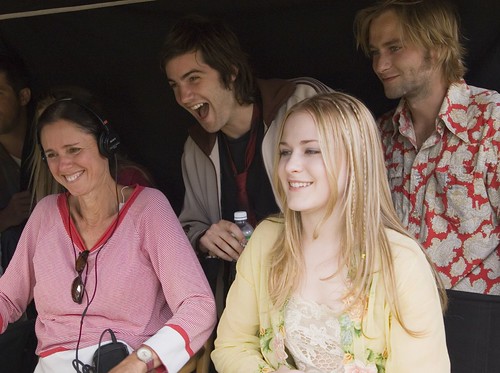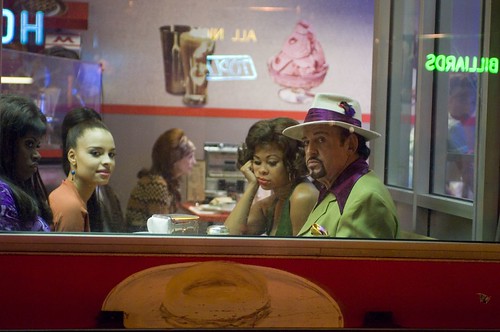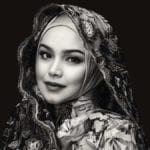Across the board, Taymor attracted an exceptional team of collaborators for Across The Universe. In the key role of cinematographer, she chose Frenchman Bruno Delbonnel, who although he has just begun shooting films in the US, is already a two-time Academy Award® nominee.
Taymor recalls: “Bruno, in our first interview said, ‘I hate musicals.’ I thought, ‘Now what  do I think about that? That’s interesting.’ And I thought, he’s done Amélie and A Very Long Engagement, these incredibly theatrical movies. He has an incredible sense of light and photography. I knew that tough, European sense with him: he would want it to be a serious movie, not fluff; that the darkness would be there when I wanted it to be there, but it would also have that whimsy and theatricality that was very important.”

Mark Friedberg (Far From Heaven, The Life Aquatic with Steve Zissou, The Producers) served as production designer. For Friedberg, it was a special opportunity to work with Taymor, a director who happens to be one of the most creative theater designers of our time. He notes, “Julie Taymor has dreams that are better than anything I could ever design.”  Taymor came in one morning and described to him the image of Vietnamese women dancing on the water as part of the montage for the song “Across the Universe,” which she had dreamt the night before. “That is not fair,” he laughs. “I want to be able to do that.”
Friedberg says that Taymor’s greatest strengths are that “she is brave and she is committed to following her ideas to their fullest. She is not afraid that they might fail.” In fact, he says, her only fear is not going far enough. “She is afraid that our ideas might not be interesting, or that we are not trying hard enough, or we are not challenging ourselves enough. It’s an amazing and inspiring way to work.”
As a result, Friedberg says, his greatest challenge on Across the Universe was not the technical process of realizing Taymor’s vision, but living up to her expectations of creating a wholly new and original work. “She let me go and get way out there and see if I would find anything she would like, and usually the stuff that was farther out was the stuff she was curious about. I wanted to interpret the 60s in a way that was relevant and interesting. I didn’t want to re-create it – I wanted to reinvent it.”
So while Friedberg’s art department began with a tremendous amount of historic research, he also had a bit of artistic freedom to reinterpret the 60s, and pull in other influences. Friedberg and Taymor looked at a lot of graffiti art from the 80s until present day for inspiration for Jude’s art and a lot of the downtown East Village neighborhood. An example of how the production design would sometimes “reinvent” the 60s was Dr. Robert’s “magic bus.” As Dr. Robert is inspired by Neal Cassady, the real-life figure who drove Ken Kesey’s famous bus Furthur, that bus became the starting point for the design; however, Taymor thought it looked somehow old. She loved Friedberg’s “Basquiat-inspired,” cool, contemporary version. Graffiti art is not true to the period, but Taymor preferred its slightly rougher, street edge to the sweeter and more flowery, more stereotypical 60s look, and it became a useful design element.

“As a designer herself, she has a very keen visual sense,” Friedberg continues. “She has a very powerful aesthetic. She’s operatic. She’s also a collaborator. She asks ‘What do you think?’ and she is always open to the best idea in the room. We had an easy vocabulary. Julie would say, ‘For the circus, I want to use a Matisse palette,’ and I knew exactly what she was talking about.”
Perhaps not surprisingly, Friedberg was most anxious about one part of the production: the film’s large-scale puppetry. He went to an expert puppet designer, Paul Rice, a top puppet maker from the theater, who had built 15 of the Pumbaa puppets for worldwide theatrical productions of Taymor’s “The Lion King.” Rice and his crew would make small maquettes of the puppets to show Taymor and she would give them her feedback, with very specific instructions on color, shading, and movement. For the circus scenes – which take their inspiration from the radical Bread & Puppet Theater, founded in the 60s in New York City – Rice would carve a puppet for about two days before a crew of about 13 people began the process of painting and paper mâché. Two of the largest puppets they built were an 18-foot-high face at the circus and a 27-foot-tall walking man at the peace march. The giant arms and hands in the circus spanned 120 feet.
One other key design challenge would be finding a visual look and for Jude’s work. A member of the art department crew named Don Nace became the source of Jude’s artistry. Friedberg had used Nace on his crew before, but was not even aware of the scope of his work until someone in the art department suggested he check out www.drawingoftheday.com, Nace’s website. Taymor liked his work the best and so the important character of Jude’s art was cast from within the crew. Jim Sturgess, the actor who plays Jude, worked alongside Nace in a studio, in preparation for the scenes (like “Strawberry Fields”) in which Jude is working. “Don would give me little tasks to do each day… We would sit and listen to Tom Waits records and he would just sit in the corner, kind of sketching and drawing and give me little things to do.”
The induction center and the VA hospital were two of the most unique stage sets. They are “bookends of the Army experience,” says Friedberg. “We made it very olive drab, black and white. Julie wanted a mechanized experience for the induction. Even the sergeants are very robotic.” During breaks in filming, the dancers playing the sergeants broke up the menacing scene by using the conveyor belt set as a “catwalk,” with each trying to do his best runway model impression while wearing full prosthetic makeup.
The induction center is one of the moments that is a true abstraction from reality, which turns into more of a musical number. Another was “Happiness Is A Warm Gun,” which takes place in a round hospital room (and features a cameo by choreographer Daniel Ezralow as a possessed dancing priest).Â

“I thought it was cruel to make the guys all look at each other,” says Friedberg. “So we made the room round. This was also a historic reference to old tuberculosis wards; when they were built in Victorian times, scientists believed that germs lived in corners. So if you had a round room you had no corners – you had no germs. On top of that, we had the idea that maybe the room would spin – the song would be stronger than gravity. It was one of the first discussions that Julie and I had.”
Another key member of the production team was legendary costume designer Albert Wolsky (an Academy Award® winner for Bugsy and All That Jazz, and an Oscar® nominee for three more films).Â
Wolsky explains that his greatest challenge was dressing the nearly 5,000 extras in the film. “Anybody who has a non-speaking part, every single one, all have to be dressed from head to toe. We did mass fittings five days a week with teams of fitters,” he says.
But even while dressing the masses, every detail is crucial, says Wolsky: “Without the right hair and makeup, the clothes won’t make any difference. You have to find ways to capture the period without making it too costume-y. I wasn’t out to make a costume ball. I wanted to make it like real clothes, but also to have this feeling of some other time.”
He continues: “What makes it interesting for me is that the beginnings are all very specific. Jude comes from Liverpool, so that’s one look. Jo-Jo comes from Detroit, that’s another look. Max and Lucy come from the Massachusetts area, that’s another look. And they all converge onto New York and the Village.”



